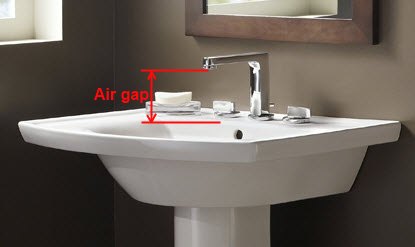Simply put, an Air Gap is the physical separation, measured vertically through air, between a water supply outlet and the flood level rim of a receptacle designed to receive the water.

An air gap in a plumbing system is a method of backflow protection used to protect the water supply from contamination caused by siphonage. So how does siphonage occur?
Here is one example:
- A home owner is filling his pool using a standard garden hose, when the municipal water main breaks. If the end of the garden hose was immersed into the pool water, it could be siphoned out as the water reverses flow toward the break. This obviously contaminates the municipal system water of unknown quality and could easily be avoided by placing the hose above the water level (air gap), as only air would then be siphoned back.
Rules for air gaps
To protect a potable water system from siphonage, a minimum unobstructed air gap of at least 1 inch or 2 pipe diameters; which ever is greater, is required. So the air gap for a 3/4″ pipe for example would need to be 1-1/2″. This may vary slightly according to your local plumbing code, but is already designed into every plumbing fixture your likely to purchase or install.
